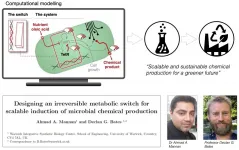Increasing the memory capacity of intelligent systems based on the function of human neurons
Researchers have developed a process that enables long-term memory capacity for intelligent systems based on the way human neurons function
2021-06-08
(Press-News.org) Researchers from the University of Liège (Belgium) have recently developed a new artificial neuron inspired by the different modes of operation of human neurons. Called a Bistable Recurrent Cell (BRC), this process has enabled recurrent networks to learn temporal relationships of more than a thousand discrete time units where classical methods failed after only a hundred time units. These important results are published in the journal PLOS One.
The enormous interest in artificial intelligence (AI) in recent years has led to the development of extremely powerful machine learning techniques. For example, time series - any series of data where a time component is present, such as stock prices, weather patterns or electroencephalograms - are by their nature extremely common and of great interest due to their wide range of applications. Time-series analysis is a type of task for which machine learning techniques are of particular interest, enabling the prediction of future events based on past events. Given the diversity of potential applications, it is logical that the processing of such data via AI algorithms has become very popular in recent years.
A particular type of artificial neural network, called a recurrent neural network (RNN), has been specially developed in recent years to have a memory that enables the network to retain information over time in order to correctly process a time series. Each time new data is received, the network updates its memory to retain this new information. Despite these developments, it is still difficult to train such networks and their memory capability is limited in time. « We can imagine the example of a network that receives new information every day, » explains Nicolas Vecoven, a doctoral student in the Systems and Modeling lab at the University of Liège and first author of the study. « but after the fiftieth day, we notice that the information from the first day had already been forgotten. »
« However, human neurons capable of retaining information over an almost infinite period of time thanks to the bi-stability mechanism. This allows neurons to stabilise in two different states, depending on the history of the electrical currents they have been subjected to, and this for an infinite period of time. In other words, thanks to this mechanism, human neurons can retain a bit (a binary value) of information for an infinite time. », Nicolas further explains. Based on this bi-stability mechanism, Nicolas Vecoven and his colleagues Damien Ernst (an AI specialist) and Guillaume Drion (a neuroscience specialist) from ULiège, have constructed a new artificial neuron with this same mechanism and have integrated it into recurrent artificial networks. Called a Bistable Recurrent Cell (BRC), this new artificial neuron has enabled recurrent networks to learn temporal relationships of more than 1000 time steps, where classical methods have failed after only about 100 time steps. These are important and promising results that have been published in the journal PLOS One. The three researchers are continuing their research in this particular field and are continuing to develop technologies to improve the memories of RNNs, by promoting the emergence of equilibrium points within them.
INFORMATION:
ELSE PRESS RELEASES FROM THIS DATE:
2021-06-08
The speed of water flow is a limiting factor in many membrane-based industrial processes, including desalination, molecular separation and osmotic power generation.
Researchers at The University of Manchester's National Graphene Institute (NGI) have published a study in Nature Communications showing a dramatic decrease in friction when water is passed through nanoscale capillaries made of graphene, whereas those with hexagonal boron nitride (hBN) - which has a similar surface topography and crystal structure as graphene - display high friction.
The team also demonstrated that water velocity could be selectively controlled by covering the high friction hBN channels with graphene, opening ...
2021-06-08
DURHAM, N.H.--Why did the deer cross the road? According to research from the University of New Hampshire to keep going and going and going. Researchers have discovered the longest distance ever recorded by an adult male white-tailed deer--300 kilometers, or close to 200 miles, in just over three weeks. The finding has important implications for population management and the transmission of disease, especially chronic wasting disease, a fatal neurological disease.
"Deer are one of the most abundant, well-known and intensely managed species of wildlife in the United States," said Remington Moll, assistant ...
2021-06-08
The bad odors produced by the Waste Water Treatment Plants, known as WWTPs, have become a growing concern in the cities and towns that host these facilities and are considered by citizens to be the main cause of the perception of pollution, along with the dust and noise.
Now, and thanks to a collaboration between the Institute for Bioengineering of Catalonia (IBEC) and the company DAM, a new way is being opened to detect and treat these odors.
According to the researchers, "the results obtained in the SNIFFDRONE project (Odor monitoring by drones for environmental purposes) are very positive and represent a significant advance ...
2021-06-08
- Most high-value chemicals are currently produced using fossil fuels - industrial chemistry's use of petroleum accounts for 14% of all greenhouse gas emissions.
- An exciting alternative is to engineer bacteria as "cell-factories" with a genetic switch that reroutes their chemistry to produce high-value chemicals, such as biofuels, polymers and pharmaceuticals.
- The use of expensive chemicals to switch them on severely limits their commercial potential, researchers have used mathematical models to develop a new genetic switch that can use a cheap natural ...
2021-06-08
JUNE 8, 2021, NEW YORK - A study conducted by researchers at the Ludwig Center at Harvard has demonstrated how a drug screening method known as dynamic BH3 profiling can be used to quickly identify potentially effective combinations of existing drugs for personalized cancer therapy.
"We know that cancer cells and healthy cells have different metabolisms," said Ludwig Harvard investigator Anthony Letai who, with former postdoctoral researcher Veerle Daniels, led the study reported in the current issue of Science Signaling. "Using BH3 profiling, we found a specific metabolic dependency in triple ...
2021-06-08
Published monthly, the journal CHEST® features peer-reviewed, cutting-edge original research in chest medicine: Pulmonary, critical care, sleep medicine and related disciplines. Journal topics include asthma, chest infections, COPD, critical care, diffuse lung disease, education and clinical practice, pulmonology and cardiology, sleep and thoracic oncology.
The June issue of CHEST includes 95 articles, clinically relevant research, reviews, case series, commentary and more. Each month, the journal also offers END ...
2021-06-08
A new Alzheimer's disease drug will hit the market soon, the first in nearly two decades. But some experts say the evidence for it isn't terribly strong and worry that it may cost a lot.
Still, the announcement of its approval by the U.S. Food and Drug Administration made headlines nationwide. The attention reflects the toll dementia takes on patients, families and society, and the lack of good treatment options.
Meanwhile, millions of adults could lower the chance that they'll ever need a drug like that. To do so, they will need to work with their primary care providers and use the power ...
2021-06-08
There is a growing body of evidence supporting airborne transmission of SARS-CoV-2, the virus that causes COVID-19. Despite updates from the World Health Organization, the U.S. Centers for Disease Control and Prevention (CDC) and the Public Health Agency of Canada that the virus can be transmitted by short- and long-range aerosols, Canada's public health guidance has not been adequately updated to address this mode of transmission, argue authors of a commentary published in CMAJ (Canadian Medical Association Journal)
Canadian public health guidance and practices should be updated to include more emphasis on the following airborne mitigation measures: ventilation, filtration and better masks.
"Ventilation is a key element in the fight against airborne transmission. We need clear guidelines ...
2021-06-08
Researchers at the University of Illinois Chicago have shown that even after lung tissue has been damaged, it may be possible to reverse fibrosis and promote tissue repair through treatment with microgel-coated mesenchymal stromal cells.
Pulmonary fibrosis is a chronic disease caused by environmental toxins, medications or medical conditions like pneumonia and rheumatoid arthritis. It is characterized by the formation of scar tissue due to damage or an unchecked immune response, and it can cause mild to severe difficulty breathing and oxygen deprivation. Fibrosis ...
2021-06-08
Most cities in São Paulo state (Brazil) have low potential capacity to adapt to climate change in terms of the ability to formulate public policy that facilitates the revamping of their housing and transportation systems, for example, to account for the impact of climate change.
This is the main conclusion of a study conducted by researchers at the University of São Paulo (USP) in partnership with colleagues at the University of Campinas (UNICAMP) and the Federal University of Itajubá (UNIFEI) in Brazil, and the University of Michigan in the United States.
Researchers linked to a project supported by FAPESP participated in the study. The results ...
LAST 30 PRESS RELEASES:
[Press-News.org] Increasing the memory capacity of intelligent systems based on the function of human neurons
Researchers have developed a process that enables long-term memory capacity for intelligent systems based on the way human neurons function







